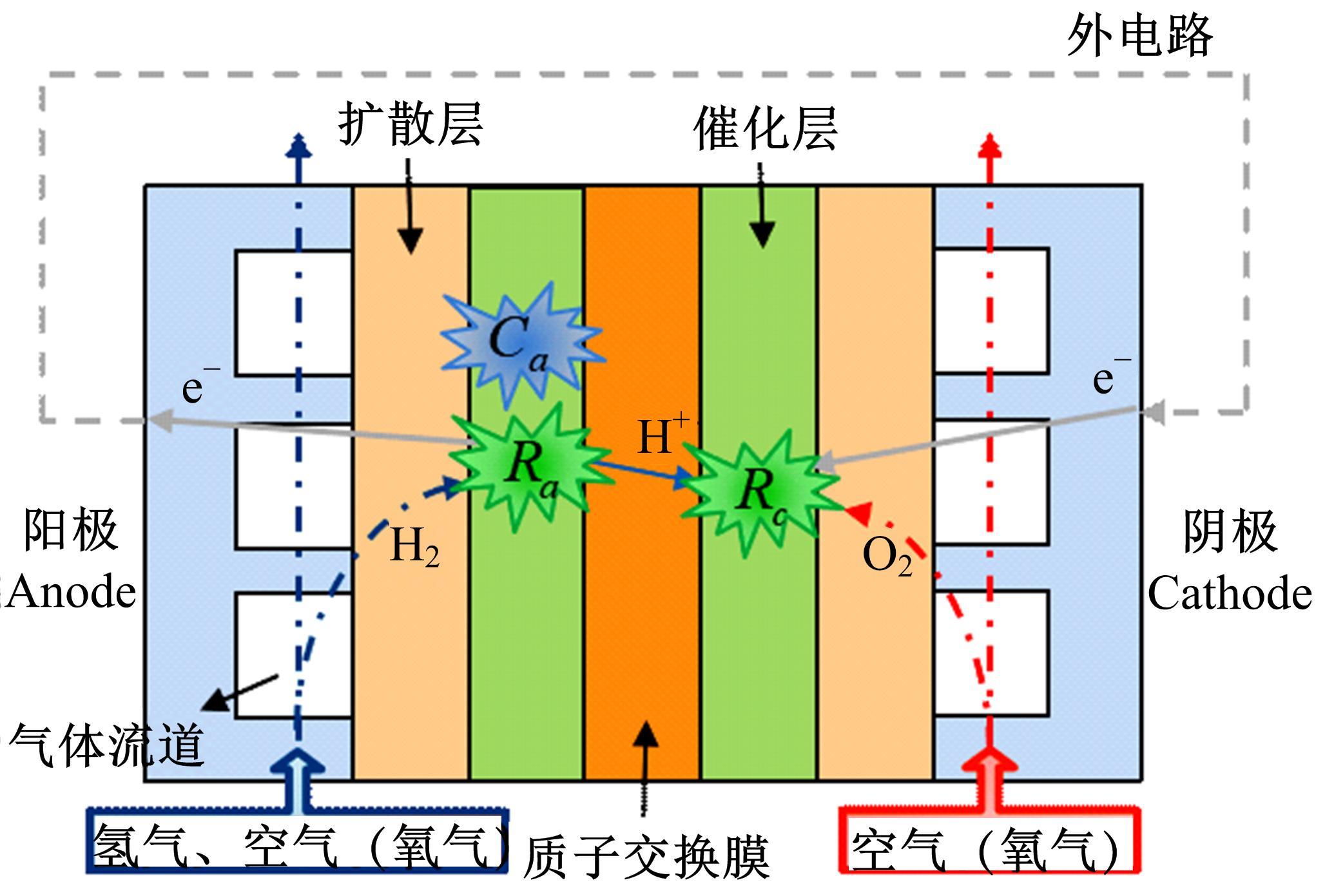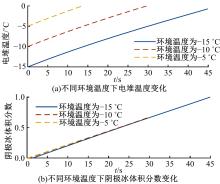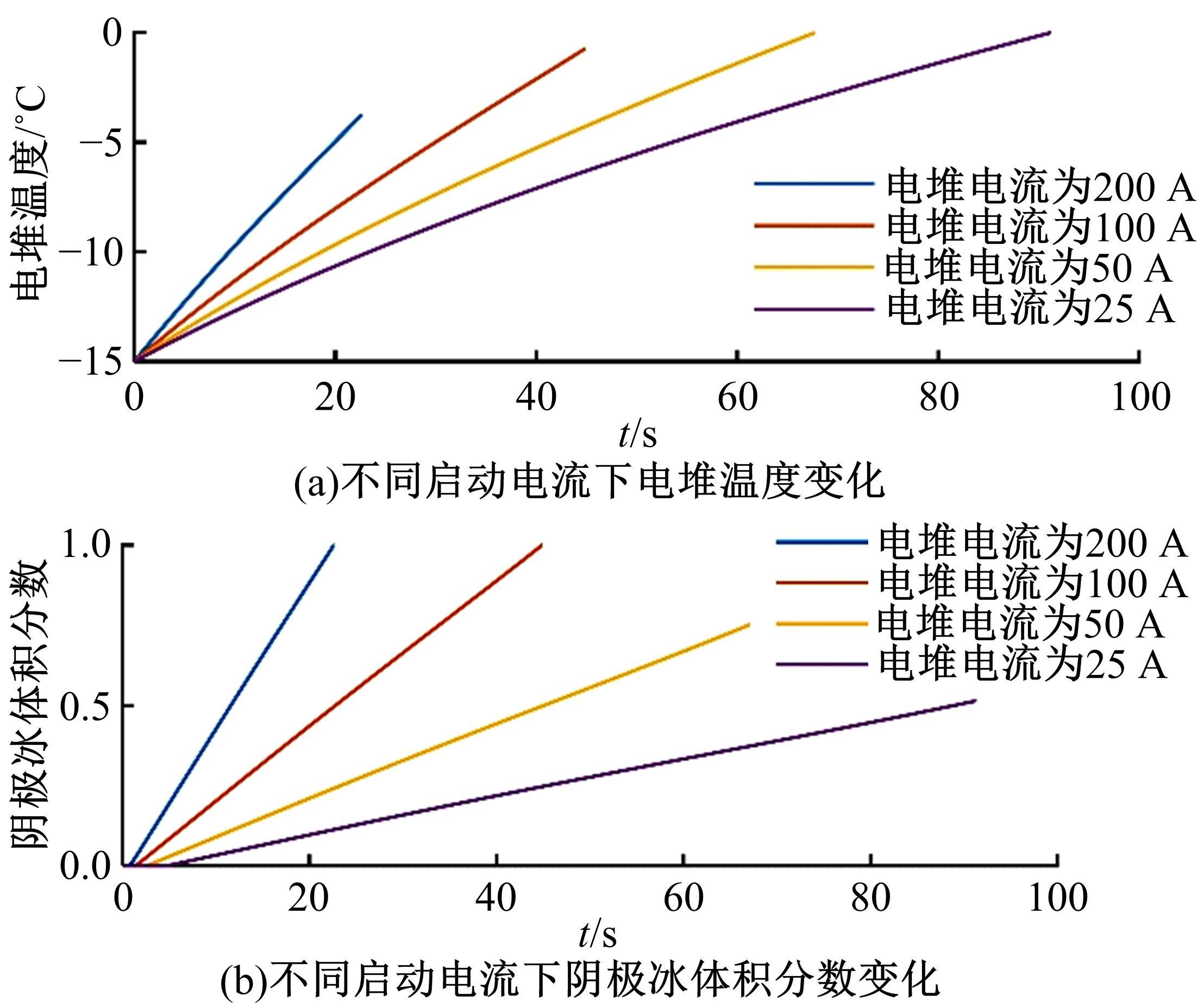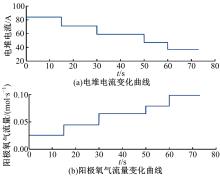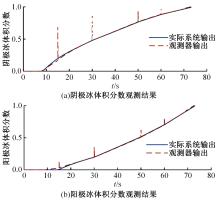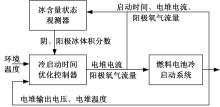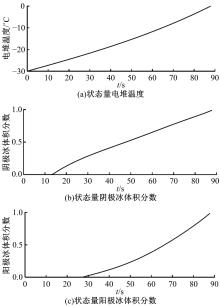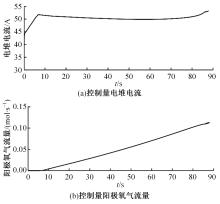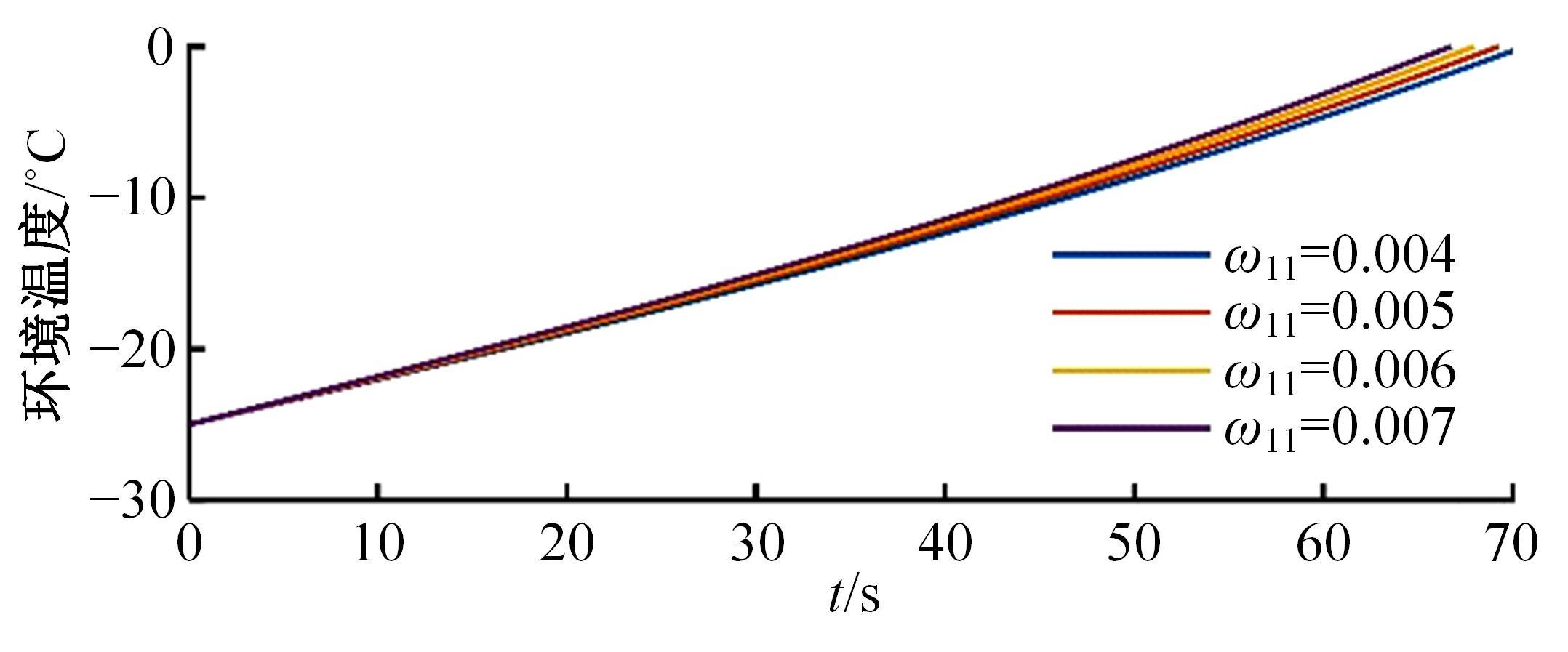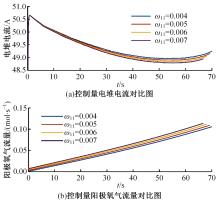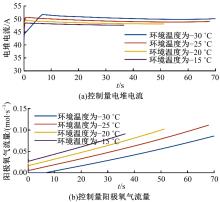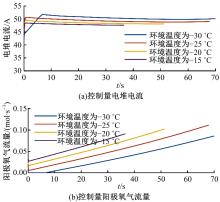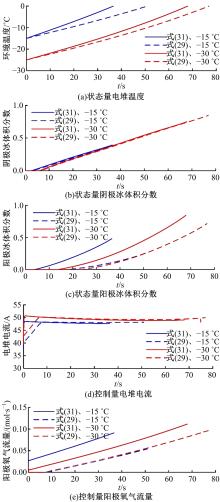吉林大学学报(工学版) ›› 2022, Vol. 52 ›› Issue (9): 2034-2043.doi: 10.13229/j.cnki.jdxbgxb20220331
• • 上一篇
低温环境下燃料电池启动优化控制方法
- 1.吉林大学 汽车仿真与控制国家重点实验室,长春 130022
2.吉林大学 通信工程学院,长春 130022
Optimal control method of fuel cell start⁃up in low temperature environment
Yun-feng HU1,2( ),Tong YU1,2,Hui-ce YANG1,2,Yao SUN1(
),Tong YU1,2,Hui-ce YANG1,2,Yao SUN1( )
)
- 1.State Key Laboratory of Automotive Simulation and Control,Jilin University,Changchun 130022,China
2.College of Communication Engineering,Jilin University,Changchun 130022,China
摘要:
结合燃料电池冷启动过程中的温度变化和结冰情况,建立了面向控制的三阶燃料电池冷启动模型。针对阴、阳极冰体积分数不可测的问题,提出了基于扩展状态观测器冰体积分数估计方法。在此基础上,针对燃料电池冷启动过程中存在的约束和耦合非线性的特点,提出了基于非线性模型预测控制的燃料电池冷启动系统优化控制方法,实现了提高冷启动系统快速性、降低耗氢量的双优化目标。最后,通过仿真实验验证了本文冷启动优化控制方法的有效性。
中图分类号:
- TK421
| 1 | 贾滨. 质子交换膜燃料电池不同冷启动模式下多相传热传质研究[D]. 天津:天津大学机械工程学院, 2016. |
| Jia Bin. Study on multiphase heat and mass transfer of proton exchange membrane fuel cell under different cold start modes[D]. Tianjin: College of Mechanical Engineering, Tianjin University, 2016. | |
| 2 | Amamou A A, Kandidayeni M, Kelouwani S, et al. An online self cold startup methodology for PEM fuel cells in vehicular applications[J]. IEEE Transactions on Vehicular Technology, 2020, 69(12): 14160-14172. |
| 3 | Chacko C, Ramasamy R, Kim S, et al. Characteristic behavior of polymer electrolyte fuel cell resistance during cold start[J]. Journal of the Electrochemical Society, 2008, 155(11): B1145-B1154. |
| 4 | Chippar P, Ju H. Evaluating cold-start behaviors of end and intermediate cells in a polymer electrolyte fuel cell (PEFC) stack[J]. Solid State Ionics, Diffusion & Reactions, 2012, 225: 85-91. |
| 5 | Luo Y, Guo Q, Du Q, et al. Analysis of cold start processes in proton exchange membrane fuel cell stacks [J]. Journal of Power Sources, 2013, 224: 99-114. |
| 6 | Jiang F M, Wang C Y. Potentiostatic start-up of PEMFCs from subzero temperatures[J]. Journal of the Electrochemical Society, 2008, 155(7): B743-B751. |
| 7 | Schiesswohl E, Unwerth T V, Seyfried F, et al. Experimental investigation of parameters influencing the freeze start ability of a fuel cell system[J]. Journal of Power Sources, 2009, 193(1): 107-115. |
| 8 | Benziger J B, Satterfield M B, Hogarth W, et al. The power performance curve for engineering analysis of fuel cells[J]. Journal of Power Sources, 2006, 155(2): 272-285. |
| 9 | Du Q, Jia B, Luo Y Q, et al. Maximum power cold start mode of proton exchange membrane fuel cell[J]. International Journal of Hydrogen Energy, 2014, 39(16): 8390-8400. |
| 10 | Ko J, Ju H. Comparison of numerical simulation results and experimental data during cold-start of polymer electrolyte fuel cells[J]. Applied Energy, 2012, 94: 364-374. |
| 11 | 崔垚鹏. 质子交换膜燃料电池冷启动策略研究[D]. 重庆:重庆理工大学机械工程学院, 2020. |
| Cui Yao-peng. Study on cold start strategy of proton exchange membrane fuel cell[D]. Chongqing: College of Mechanical Engineering, Chongqing University of Technology, 2020. | |
| 12 | Manabe K, Naganuma Y, Nonobe Y. Development of fuel cell hybrid vehicle rapid start-up from sub-freezing temperatures[C]∥SAE Technial Paper, 2010-01-1092. |
| 13 | Roberts J, van der Geest M, St-pierre J. Method and apparatus for increasing the temperature of a fuel cell[P]. US:6764780, 2004-07-20. |
| 14 | Silva R E, Harel F, Jeme S, et al. Proton exchange membrane fuel cell operation and degradation in short-circuit[J]. Fuel Cells, 2015, 14(6): 894-905. |
| 15 | 常贵可. 质子交换膜燃料电池冷启动性能仿真与启动策略研究[D]. 淄博:山东理工大学交通与车辆工程学院,2020. |
| Chang Gui-ke. Study on cold start performance simulation and start-up strategy of proton exchange membrane fuel cell[D]. Zibo: College of Transportation and Vehicle Engineering, Shandong University of Technology,2020. | |
| 16 | Guo H P, Sun S C, Yu H M, et al. Proton exchange membrane fuel cell subzero start-up with hydrogen catalytic reaction assistance[J]. Journal of Power Sources, 2019, 429: 180-187. |
| 17 | Sun S C, Yu H M, Hou J B, et al. Catalytic hydrogen/oxygen reaction assisted the proton exchange membrane fuel cell (PEMFC) startup at subzero temperature[J]. Journal of Power Sources, 2008, 177(1): 137-141. |
| 18 | Luo Y Q, Jia B, Jiao K, et al. Catalytic hydrogen-oxygen reaction in anode and cathode for cold start of proton exchange membrane fuel cell[J]. International Journal of Hydrogen Energy, 2015, 40(32): 10293-10307. |
| 19 | Zheng Q, Gao L Q, Gao Z Q. On validation of extended state observer through analysis and experimentation[J]. Journal of Dynamic Systems Measurement and Control, 134(2): No.024505. |
| [1] | 刘继宗,吴小平,孔维华. 基于鱼群优化算法的有轨电车用燃料电池混合动力系统参数配置[J]. 吉林大学学报(工学版), 2022, 52(9): 2004-2013. |
| [2] | 杨子荣,李岩,冀雪峰,刘芳,郝冬. 质子交换膜燃料电池运行工况参数敏感性分析[J]. 吉林大学学报(工学版), 2022, 52(9): 1971-1981. |
| [3] | 张佩,王志伟,杜常清,颜伏伍,卢炽华. 车用质子交换膜燃料电池空气系统过氧比控制方法[J]. 吉林大学学报(工学版), 2022, 52(9): 1996-2003. |
| [4] | 刘镇宁,江柯,赵韬韬,樊文选,卢国龙. 大功率质子交换膜燃料电池测试系统的开发及试验[J]. 吉林大学学报(工学版), 2022, 52(9): 2025-2033. |
| [5] | 陈凤祥,张俊宇,裴冯来,侯明涛,李其朋,李培庆,王洋洋,张卫东. 质子交换膜燃料电池氢气供应系统的建模及匹配设计[J]. 吉林大学学报(工学版), 2022, 52(9): 1982-1995. |
| [6] | 裴尧旺,陈凤祥,胡哲,翟双,裴冯来,张卫东,焦杰然. 基于自适应LQR控制的质子交换膜燃料电池热管理系统温度控制[J]. 吉林大学学报(工学版), 2022, 52(9): 2014-2024. |
| [7] | 池训逞,侯中军,魏伟,夏增刚,庄琳琳,郭荣. 基于模型的质子交换膜燃料电池系统阳极气体浓度估计技术综述[J]. 吉林大学学报(工学版), 2022, 52(9): 1957-1970. |
| [8] | 刘远红,郭攀攀,张彦生,李鑫. 基于黎曼流形的稀疏图保持投影的特征提取[J]. 吉林大学学报(工学版), 2021, 51(6): 2268-2279. |
| [9] | 何德峰,罗捷,舒晓翔. 自主网联车辆时滞反馈预测巡航控制[J]. 吉林大学学报(工学版), 2021, 51(1): 349-357. |
| [10] | 贾超,徐洪泽,王龙生. 基于多质点模型的列车自动驾驶非线性模型预测控制[J]. 吉林大学学报(工学版), 2020, 50(5): 1913-1922. |
| [11] | 王哲,谢怡,臧鹏飞,王耀. 基于极小值原理的燃料电池客车能量管理策略[J]. 吉林大学学报(工学版), 2020, 50(1): 36-43. |
| [12] | 石屹然, 田彦涛, 史红伟, 张立. 基于Modified Volterra模型的SI发动机空燃比非线性模型预测控制[J]. 吉林大学学报(工学版), 2014, 44(2): 538-547. |
| [13] | 侯中军, 江洪春, 王仁芳, 胡军, 马由奇, 王克勇, 燕希强, 戚朋, 明平文. 轿车用燃料电池发动机示范应用稳定性[J]. 吉林大学学报(工学版), 2011, 41(增刊2): 131-136. |
| [14] | 于树友, 陈虹, 赵海艳. 非线性离散时间系统的准无限时域NMPC[J]. 吉林大学学报(工学版), 2009, 39(04): 1002-1006. |
| [15] | 徐云飞,金振华,卢青春,闫东林 . 能量混合型燃料电池城市客车 系统设计与性能测试 [J]. 吉林大学学报(工学版), 2007, 37(02): 296-0300. |
|
||

